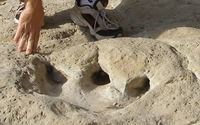|
|
We
don't usually think of dinosaurs when we think of Texas.
We might think about the state's officially designated large mammal,
the Longhorn,
or the state small mammal, the armadillo. We know that the state
bird is the mockingbird, the state tree is the pecan and the horned
lizard (or horny toad, as most of us call it) is the state reptile.
Rock hounds might even know that the state stone is petrified palm
wood. Seldom is heard a word, discouraging or otherwise, about the
state dinosaur, the Pleurocoeleus.
Whether or not Texas actually needs a state dinosaur is open to
debate, but the Pleurocoeleus (Brachiosaur sauropod) was so designated
by the state legislature 1997. It’s our dinosaur, by golly, and
we're Texans so we're going to be proud of it, even if it wasn't
what you might call ferocious. You might think that Texas
would have adopted a carnivore, but our dinosaur was a strict vegetarian.
At least it was big — about 50 feet long and it weighed in at about
20 tons. Paleontologists tell us that despite its size, our dinosaur
was decidedly mild-mannered. Fight or flight? The Pleurocoeleus
probably didn’t have to give the matter a lot of thought.
We can watch and listen to mockingbirds, pick pecans and we know
a Longhorn cow when he see one and an armadillo, which we can't
always avoid when they try to cross the road. The Pleurocoeleus
hasn't been seen in these parts for, oh, about 65 million years,
give or take a few million years either way. But we have proof that
they lived here.
|
 |
Near
Glen
Rose, at the appropriately named Dinosaur
Valley State Park, on the banks of the Paluxy River and in the
riverbed itself, are some remarkably well preserved Pleurocoeleus
tracks. These are some of the best dinosaur tracks in the world, which
is why paleontologists love the park and have ever since Roland T.
Bird of the American Museum of Natural History visited the site in
1938. Bird realized that a set of double tracks showed a herbivorous
sauropod —most likely our boy, the Pleurocoeleus — being chased by
a meat-eating carnosaur.
This was the first time sauropod tracks had been discovered anywhere
in the world, which caused no small amount of excitement back in New
York. The Glen
Rose tracks were duly sent to New York and displayed at the American
Museum of Natural History. The Pleurocoeleus obviously couldn't get
away from the site fast enough on that particular day, but since then
its tracks have been scattered hither and yon, to the Texas Memorial
Museum in Austin and, unfortunately,
into the private residences of many amateurs, or vandals, depending
on how you look at these things.
The dinocaur tracks are a major wonder but it’s a small wonder that
any tracks are left here at all. People complain that all the “good”
tracks have been removed from the Paluxy River valley. A woman in
Glen
Rose told me that a lot of area families have a quarried dinosaur
track or two in their homes. “You usually see them on people’s living
room wall,” she said.
It took a special set of circumstances to preserve the tracks for
all these millions of years. Scientists believe that a violent storm
blew across the shoreline a few days before the tracks were made and
created a series of sand and lime-laden mudflats. A herd of Pleurocoeleus
came ambling across the sticky and still-wet mud in search of a primordal
salad, followed in interested pursuit by the carnosaurs looking for
some fresh sauropods; the Pleurocoeleus qualified.
True to their pacifistic nature, the Pleurocoeleus tried to run away
but we don't know if they won that particular footrace or not. No
intact skeleton remains were ever found, just huge saucer-like depressions
from their hind feet and smaller tracks, much like horseshoes, from
their front legs.
The primal, existential struggle for food and survival was preserved
in stone when the seashore turned to stone, leaving behind the rocks
we see in the park today, including the ones with the dinosaur prints.
We
in Texas have never collected dinosaur
fossils like we have collected, say, arrowheads, but the state has
had its fair share of fossilized dinosaur discoveries over the years
due to a quirk of ancient geography dating back to when much of what
is now Texas was covered any an ancient
sea.
As the sea level rose, the land was covered with ocean silt. Sediments
on the bottom of the ocean preserved things that lived in the ocean.
At lower sea levels, things that lived on land were preserved in sediments
left in streams and rivers, like the Paluxy.
As a result, dinosaur discoveries in Texas
have included both the marine and terrestrial, along with the ones
that flew over land and sea. While having a state dinosaur might seem
like a trivial thing — it is — and maybe even a waste of legislative
time, it’s not a bad idea to take official note of ancient Texas.
As Texans, we have always prided ourselves on our connection to the
wild, whether it’s wild Comanches or wild animals or wild land. And
wildness is wildness, whether it’s slinking across your pasture tonight
or it lived millions of years ago and you’re literally walking in
its footsteps.
© Clay Coppedge
"Letters from Central Texas"
March
17 , 2008 Column |
|
|
